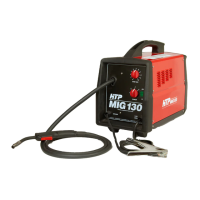7
not tiled, carpeted, or made of any other
flammable material.
• Protect flammable walls, ceilings, and
floors with heat resistant covers or
shields.
• Check welding area to make sure it
is free of sparks, glowing metal or slag, and
flames before leaving the welding area.
FUME HAZARDS
WARNING
FUMES, GASSES, AND VAPORS CAN CAUSE
DISCOMFORT, ILLNESS, AND DEATH! To
reduce the risk of discomfort, illness, or
death, read, understand, and follow the fol-
lowing safety instructions. In addition, make
certain that anyone else that uses this weld-
ing equipment or is a bystander in the weld-
ing area, understands and follows these safe-
ty instructions as well.
• Do not weld in an area until it is checked
for adequate ventilation as described in
ANSI standard #Z49.1. If ventilation is not
adequate to exchange all fumes and
gasses generated during the welding
process with fresh air, do not weld unless
you (the welder) and all bystanders are
wearing air-supplied respirators.
• Do not heat metals coated with, or that
contain, materials that produce toxic
fumes (such as galvanized steel), unless
the coating is removed. Make certain the
area is well ventilated, and the operator
and all bystanders are wearing air-sup-
plied respirators.
• Do not weld, cut, or heat lead, zinc, cad-
mium, mercury, beryllium, or similar met-
als without seeking professional advice
and inspection of the ventilation of the
welding area. These metals produce
EXTREMELY TOXIC fumes which can cause
discomfort, illness, and death.
• Do not weld or cut in areas that are near
chlorinated solvents. Vapors from chlori-
nated hydrocarbons, such as trichloroeth-
ylene and perchloroethylene, can be
decomposed by the heat of an electric arc
or its ultraviolet radiation. These actions
can cause PHOSGENE, a HIGHLY TOXIC gas
to form, along with other lung and eye-irri-
tating gasses. Do not weld or cut where
these solvent vapors can be drawn into the
work area or where the ultraviolet radia-
tion can penetrate to areas containing
even very small amounts of these vapors.
• Do not weld in a confined area unless it is
being ventilated or the operator (and any-
one else in the area) is wearing an air-sup-
plied respirator.
• Stop welding if you develop momentary
eye, nose, or throat irritation as this indi-
cates inadequate ventilation. Stop work
and take necessary steps to improve ven-
tilation in the welding area. Do not
resume welding if physical discomfort
persists.
COMPRESSED GASSES AND
EQUIPMENT HAZARDS
WARNING
IMPROPER HANDLING AND
MAINTENANCE OF COMPRESSED GAS
CYLINDERS AND REGULATORS CAN
RESULT IN SERIOUS INJURY OR DEATH! To
reduce the risk of injury or death from com-
pressed gasses and equipment hazards, read,
understand, and follow the following safety
instructions. In addition, make certain that
anyone else who uses this welding equip-
ment or a bystander in the welding area
understands and follows these safety instruc-
tions as well.
• Do not use flammable gasses with MIG
welders. Only inert or nonflammable
gasses are suitable for MIG welding.
Examples are Carbon Dioxide, Argon,
Helium, etc. or mixtures of more than one
of these gasses.
• Do not attempt to mix gasses or refill a
cylinder yourself. Do not expose cylinders
to excessive heat, sparks, slag and flame,
etc. Cylinders exposed to temperatures
above 130°F will require water spray cool-
ing.
• Do not expose cylinders to electricity of
any kind.

